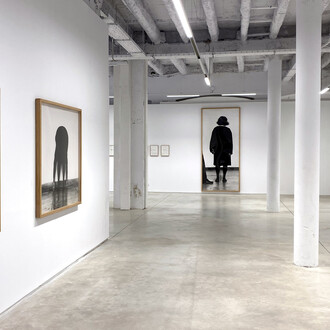Nogueras Blanchard is pleased to present Canons, a solo exhibition by Elena Asins (Madrid, 1940 - Navarra, 2015), a pioneer of digital art in Spain.
A self-taught artist, Asins co-founded the Cooperativa de Producción Artística y Artesana, a group parallel to abstract expressionism linked to the avant-garde current of constructivism. In 1969, Asins became a member of the Centro de Cálculo de la Universidad Complutense de Madrid (Computing Centre of Madrid Complutense University), where she began her research with the computer as an instrument of artistic creation.
Throughout her career, Asins developed a structuralist working method influenced by semiotics, mathematical logic, information theory and concrete poetry. Her monochromatic and geometric works, created from algorithms and numerical series, aimed to create new structures of thought; an autonomous world, far removed from symbolism, based on order and the formal purity of movement. A radical approach to conceptual art that endowed her work with a provocative nature.
This exhibition brings together various works from the series titled Canons, digitally produced drawings that pay homage to the canonical forms of Johann Sebastian Bach, for whom the artist had great admiration. Asins’ passion for music and its temporality played a key role in the development of her works, which, like musical scores, are codified. In these pictorial compositions we can appreciate her obsession with the order in the placement of the notes in the meter, rhythms, silences, repetition and mutation.
Elena Asins (Madrid, 1940 – Azpíroz, Navarra, 2015) was a precursor of conceptual art in Spain and a pioneer in the application of digital art and creation based on algorithms. She developed an intense career that culminated with two major awards, the Medalla de Oro al Mérito en las Bellas Artes (2006) and the Premio Nacional de Artes Plásticas (2011), and an anthological exhibition at the Museo Nacional Centro de Arte Reina Sofía that same year. Her work can be found in museums and private and public collections, such as the Museo Nacional Centro de Arte Reina Sofía, Museo de Arte Abstracto de Cuenca, Museo de Bellas Artes de Álava, Instituto Valenciano de Arte Moderno, Museu d’Art Contemporani Vicente Aguilera Cerní de Vilafamés, Banesto Foundation, Unión Fenosa Collection, Museo de Arte Contemporáneo de Alicante or the Museo de Bellas Artes de Bilbao, among others.
Music to be heard inwardly. Painting to be seen inwardly. Invisibility. As blind Bach wrote music, and as deaf Beethoven composed it, as blind Rembrandt painted, so, in prospect rather than in a return to the past, what I propose is to try not to see in order to profoundly see, in a symbolic transfiguration, in the scarce visuality of a world ungraspable by the senses.
(Elena Asins, 1988)
















